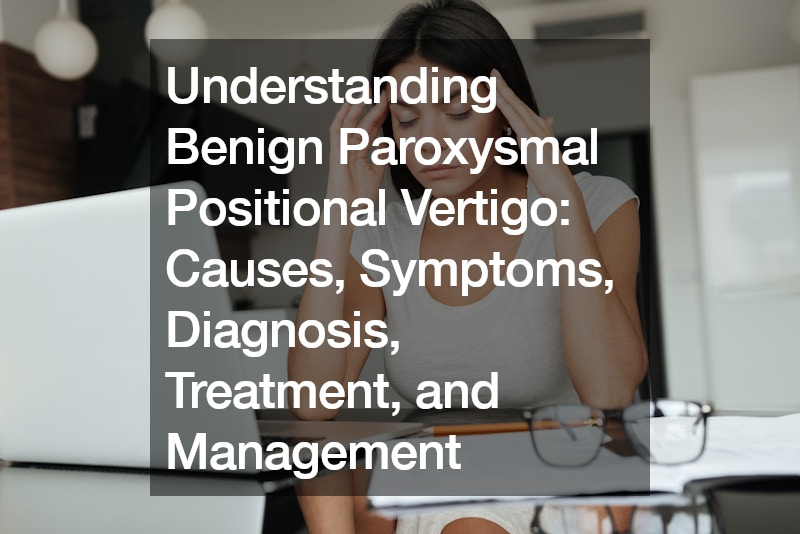Benign Paroxysmal Positional Vertigo (BPPV) is a prevalent vestibular disorder characterized by brief episodes of vertigo triggered by specific head movements. While not life-threatening, BPPV can significantly impact an individual’s quality of life, causing discomfort and disrupting daily activities. Here, we delve into the various aspects of BPPV, including its causes, symptoms, diagnosis, treatment options, and management strategies.
Causes of BPPV:
BPPV occurs when tiny calcium carbonate crystals, known as otoconia, dislodge from the utricle (a part of the inner ear) and migrate into the semicircular canals. These canals are responsible for detecting rotational movements of the head.
When the otoconia enter the canals, they interfere with the normal flow of fluid, leading to abnormal signals being sent to the brain about head position and movement.
While the exact cause of otoconia displacement is not always clear, certain factors may contribute to its occurrence. These factors include head trauma, inner ear infections, degenerative changes in the inner ear structures, and idiopathic reasons, meaning the cause is unknown.
Symptoms of BPPV:
The hallmark symptom of BPPV is vertigo, a sensation of spinning or whirling that can be triggered by specific head movements. Other common symptoms include dizziness, loss of balance, lightheadedness, nausea, vomiting, and involuntary rapid eye movements known as nystagmus.
Symptoms of BPPV can vary in intensity and duration among individuals. While some may experience brief episodes lasting only a few seconds, others may endure more prolonged bouts of vertigo that persist for several days.
Diagnosis of BPPV:
Diagnosing BPPV typically involves a comprehensive evaluation by a healthcare professional, often a BPPV specialist. This evaluation may include a thorough medical history review, focusing on symptoms and potential risk factors, followed by a physical examination.
During the physical examination, specific maneuvers, such as the Dix-Hallpike test, may be performed to provoke and assess vertigo and nystagmus. Additionally, diagnostic tests such as electronystagmography (ENG), magnetic resonance imaging (MRI), and electroencephalography (EEG) may be utilized to further evaluate inner ear function and rule out other potential causes of vertigo.
Treatment Options for BPPV:
Treatment strategies for BPPV aim to alleviate symptoms, reduce the frequency and severity of vertigo episodes, and improve overall quality of life. Several approaches may be employed, depending on the severity and underlying cause of the condition.
One commonly used treatment maneuver is the Epley maneuver, a series of head movements designed to reposition displaced otoconia within the inner ear’s semicircular canals. This maneuver helps restore normal fluid dynamics and alleviate vertigo symptoms. Another similar technique is the Semont maneuver, which employs rapid head movements to achieve a similar goal.
In addition to canalith repositioning maneuvers, vestibular rehabilitation exercises may be recommended to improve balance and reduce symptoms of dizziness and lightheadedness associated with BPPV. These exercises focus on habituating the brain to movements that trigger vertigo, helping to desensitize the vestibular system over time.
For individuals with persistent or severe symptoms, medications such as betahistine may be prescribed to alleviate vertigo and associated discomfort. Betahistine works by improving blood flow to the inner ear and reducing the frequency and intensity of vertigo episodes.
Management Strategies for BPPV:
In addition to specific treatments, certain lifestyle modifications and management strategies can help individuals better cope with BPPV and reduce the likelihood of vertigo episodes. These may include:
- Avoiding sudden head movements or positions that trigger vertigo, such as looking up or bending over quickly.
- Using supportive measures such as handrails or walking aids to improve stability and prevent falls during vertigo episodes.
- Practicing relaxation techniques, such as deep breathing or meditation, to reduce stress and anxiety associated with vertigo.
- Maintaining a healthy lifestyle, including regular exercise, balanced nutrition, and adequate hydration, to support overall well-being and vestibular function.
- Seeking ongoing support and guidance from healthcare professionals, including BPPV specialists, to monitor symptoms, adjust treatment plans as needed, and address any concerns or challenges that arise.
In conclusion, BPPV is a common vestibular disorder characterized by brief episodes of vertigo triggered by specific head movements. While the condition can be disruptive and uncomfortable, effective treatment options and management strategies are available to alleviate symptoms and improve quality of life. If you experience symptoms of BPPV, it is essential to seek evaluation and guidance from a healthcare professional, preferably a BPPV specialist, to determine the most appropriate course of action for your individual needs. By understanding the causes, symptoms, diagnosis, treatment options, and management strategies for BPPV, individuals can take proactive steps to manage their condition effectively and minimize its impact on their daily lives.
.




